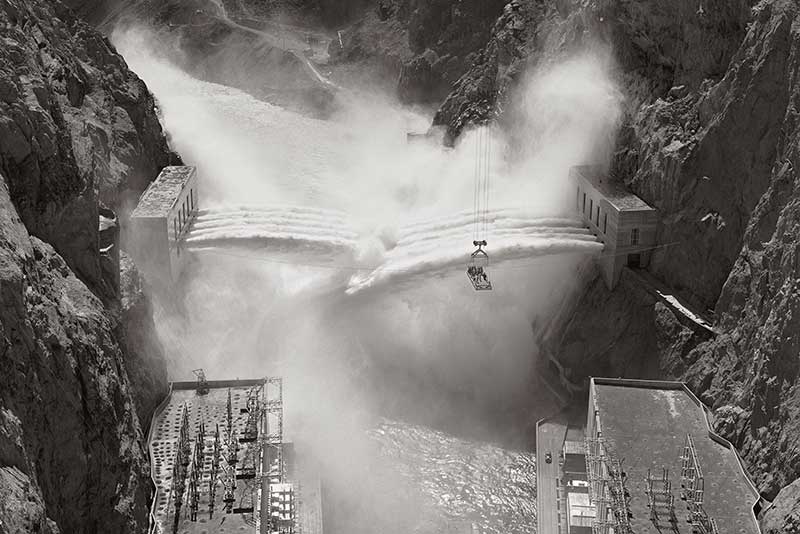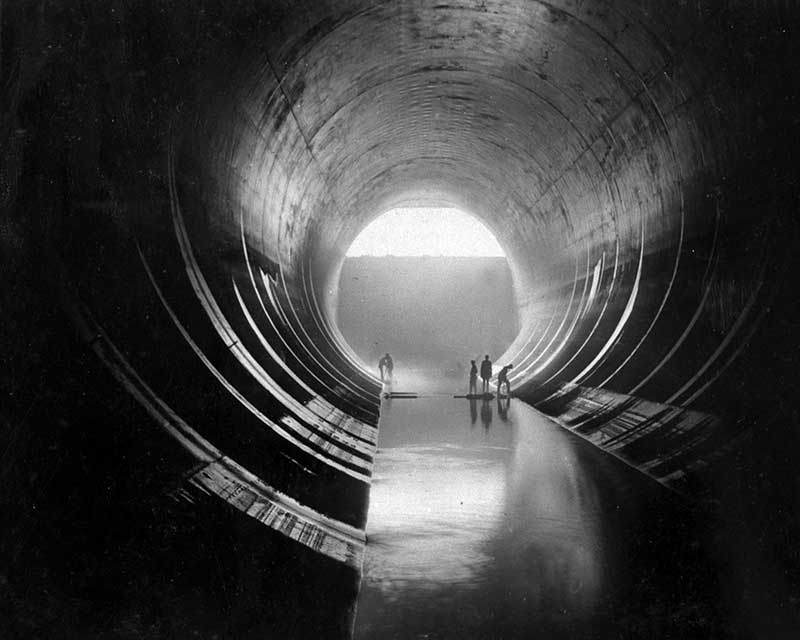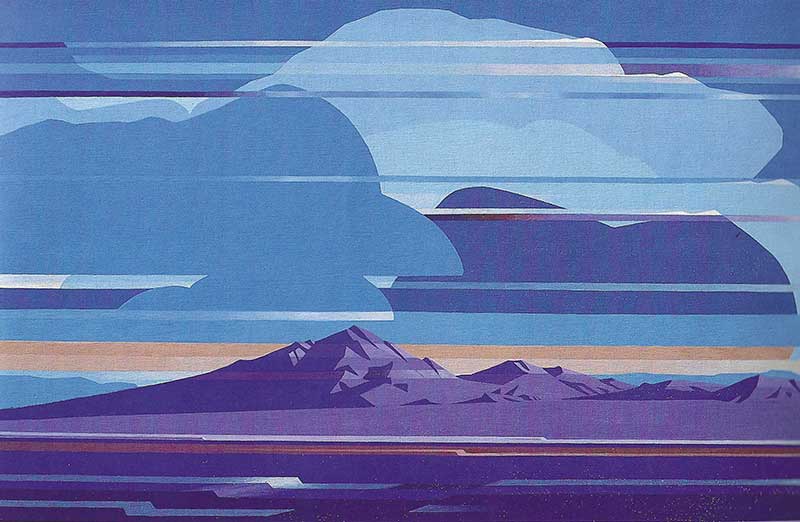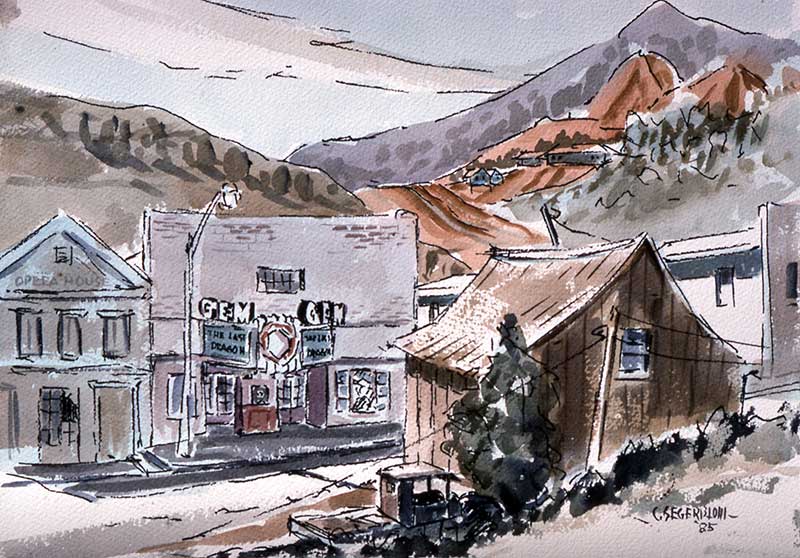![Fremont-Street,-Las-Vegas,-NV-[Sept-1957]](https://chiccompass.com/wordpress/wp-content/uploads/2024/08/Fremont-Street-Las-Vegas-NV-Sept-1957.jpg)
Fremont Street, Las Vegas, NV [Sept 1957] Cliff Segerblom
Cliff Segerblom
The Artistic Chronicler of a Disappearing Nevada
By Laura Henkel
Imagine standing on the edge of the Nevada desert, the sun setting in a blaze of colors and seeing the landscape through the eyes of Cliff Segerblom. As one of Nevada’s most prolific and versatile artists, Segerblom’s boundless love for the state propelled its breathtaking landscapes and rich history onto the national and international stage. His stunning photography and vivid paintings captured the essence of the Silver State and elevated it to a place of prominence in the art world. Through his multifaceted career, he brilliantly combined artistry with historical documentation, creating a legacy that inspires and educates future generations. His work is a testament to the power of art in preserving the natural beauty and cultural heritage of Nevada while showcasing it to the world.

Hoover Dam Needle Test c1940s Cliff Segerblom
The Photography of Cliff Segerblom: A Visual Chronicle
Upon his graduation in 1938, Segerblom relocated to Boulder City. He was offered a job as a photographer with the Bureau of Reclamation to document the construction of the Hoover Dam. Despite having yet to take a picture, Segerblom quickly proved his talent. He was given an 8×10 view camera, which he recalled “must have weighed 50 pounds and the tripod at least 100 more.” This cumbersome equipment required great physical effort and precision, especially in the challenging terrain and harsh conditions surrounding the construction site. With these tools, he captured timeless moments that solidified him as a distinguished photographer in American culture.
While photographing the Hoover Dam, he worked alongside and observed legendary photographers such as Margaret Bourke-White, Ansel Adams, George Strock, Edward Weston, Bill Belknap and Alfred Eisenstaedt. The most valuable mentorship during this time came from Charles Sheeler, who did a series of covers for Fortune Magazine. Sheeler taught Segerblom how to use the camera for painting, emphasizing techniques to shoot without distortion and capture subjects with a truer perspective, mirroring how a person sees rather than how the camera sees.

Hoover Dam Workers c1940s Cliff Segerblom
At the time, Nevada’s population was only 90,000, and in the pre-internet era, magazines were the primary source of information for people near and far. His photos, which spoke volumes, have appeared in prestigious national and regional magazines such as Life, Time, National Geographic and Sports Illustrated. His iconic photo depicting the needle test, with valves spouting water into the Black Canyon, was even exhibited at the Museum of Modern Art in New York. Segerblom’s photographic dexterity catapulted him into the international spotlight, showcasing his extraordinary insight. Yet he remained humble, devoid of celebrity flair, just a man of pure heart.
In 1941, Segerblom married Genevieve “Gene” Wines, a fourth-generation Nevadan from Ruby Valley, who also became renowned for her contributions to the arts, politics and advocacy for social causes. Together, they moved to Panama, where Segerblom was assigned to photograph the Third Locks Project on the Panama Canal. However, Pearl Harbor occurred shortly after arriving in Panama, which canceled the project. Instead, Segerblom ran the photography lab at the army base in the canal zone. During World War II, Segerblom was a civilian employee for the Sixth Air Force, teaching soldiers film techniques for reconnaissance work. After the war, Segerblom returned to Boulder City, where he first formed a photography company and then went on to do freelance work independently. In a 2010 Las Vegas Review-Journal article, Gene reminisced, “We toured every inch of the state. These little villages were wonderful and such fun. Some had nowhere to stay, so we’d sleep in our car.” As an accomplished writer, she provided over 200 stories accompanying his evocative depictions for Nevada Magazine, Nevada Highways and Parks, Arizona Highway and numerous regional publications.
Segerblom’s photographic legacy is largely preserved at the Las Vegas News Bureau and the Nevada State Museum. His photographic portfolio includes:
- Construction of Hoover Dam: As previously mentioned, his black-and-white photographs of the Hoover Dam project are iconic. They capture the technical prowess and sheer scale of the construction, highlighting the human element involved. Images like the “Workers at the Dam” series reveal the grit and determination of the laborers, offering a powerful narrative of human endeavor and engineering triumph.
- Las Vegas Glitz, Glamour and Everyday Life: From the 1950s to the 1980s, he chronicled the glitz, glamour and local culture as a freelancer for the Las Vegas News Bureau. His photographs from this period capture the vibrant nightlife, iconic entertainers and the city’s dynamic growth, providing a vivid record of an era that shaped Las Vegas into the entertainment capital it is today.
- Colorado River: Over his lifetime, Segerblom photographed the Colorado River from the Supai Indian Reservation in the Grand Canyon all the way to the Gulf of Mexico — some 1500 miles.
- Rural Nevada: Segerblom focused on the quieter, more personal aspects of Nevada life. His series on rural homesteads and small-town life captures the simplicity and resilience of rural communities, providing a poignant commentary on the effects of urbanization and modernization. Many of these photographs inspired future paintings.

Vegas Valley 1986 Acrylic Cliff Segerblom
A Master of Mediums: Paintings of the American West
Segerblom’s paintings vividly reflect his deep appreciation for the natural beauty of the American West. His studies with prominent Nevada artists Robert Caples and Hans Meyer-Kassel profoundly influenced his work. Their mentorship helped shape his unique artistic vision and approach to capturing the landscapes and culture of Nevada. Working in watercolor, block printing, sketching, oils and acrylics, he explored different aspects of his subjects, bringing out unique textures, colors and emotions. In 1969, the Navy commissioned Segerblom to record the Apollo 12 splashdown in the South Pacific. The National Aeronautics and Space Museum currently displays six watercolors from this project.
Segerblom’s watercolor paintings, celebrated for their delicate yet expressive quality, capture the essence of Nevada’s towns and landscapes. An excellent example is his depiction of the Gem Theater in Pioche, Nevada. This 1985 painting portrays the historic theater against rugged hills and a small town’s architecture. The muted tones and careful brushwork bring out the scene’s nostalgic charm, reflecting the location’s cultural and historical significance. The Gem Theater, with its distinct signage and surrounding buildings, offers a glimpse into the everyday life and evolving history of small-town Nevada. Efforts by local advocate Melissa Clary to revitalize the Gem Theater highlight its importance to the community, ensuring that this cultural landmark continues to be a focal point for residents and visitors alike. A short film featuring his watercolors by Mercedes Maharis can be enjoyed on the Cliff Segerblom Art website, offering a dynamic visual journey through his impressive body of work.
His use of acrylics to create richer textures and deeper intensity is incredibly inviting. “Political Circus” (1986) stands out for its portrayal of a deserted station on the old Las Vegas – Salt Lake Highway. The juxtaposition of political signage and commercial advertisements like Coca-Cola against a desolate backdrop offers a poignant commentary on the transient nature of political campaigns and the passage of time. In contrast, “Vegas Valley” (1986) presents Sunrise Mountain in the early light with a more abstract, modern approach. The bold colors and simplified forms in this painting highlight the serene beauty of the Nevada desert at dawn. The contrast between these works underscores his versatility.

Gem Theater 1985 Watercolor Cliff Segerblom
Comparisons to Contemporary Artists
Segerblom’s work stands out when compared to his contemporaries. While many artists of his time focused solely on either painting or photography, Segerblom masterfully navigated both mediums. This unique ability places him in the company of internationally renowned artists like Ansel Adams, known for his black-and-white landscape photographs of the American West, who share Segerblom’s dedication to capturing the beauty of natural environments. Adams’ meticulous attention to detail and his ability to evoke emotional responses through his images resonate with Segerblom’s work. Similarly, David Hockney’s vibrant multi-medium explorations of his surroundings echo Segerblom’s versatility and impact. With his use of painting, photography and digital art, Hockney demonstrates a kindred spirit in Segerblom’s multifaceted approach and his passion for depicting the world around him.
Like Georgia O’Keeffe, whose works are known for her paintings of the American Southwest, capturing the essence of its vast landscapes, distinctive architecture and unique flora, Segerblom’s work immortalizes a region and its changing environment. His contemporary and colleague at the University of Nevada, Las Vegas (UNLV) College of Fine Arts, Rita Deanin Abbey, was also a prolific multidisciplinary artist who shared this passion. Abbey’s work in various mediums and her ability to interpret the Southwestern landscape through art further enriched the cultural tapestry of Nevada, fostering a deep respect for the state’s exquisite natural beauty amidst its urbanization.
Educational Impact and Continued Relevance
Segerblom’s legacy extends into education. He founded the UNLV Photography Department, where he taught part-time for 20 years, setting up the first darkroom. His work is used in academic settings to teach students about Nevada’s history and the importance of documenting cultural and environmental changes. His contributions are a cornerstone in the curriculum of art and history departments, providing a rich resource for research and learning. Segerblom’s words encapsulate his philosophy and approach to painting and photography. In the 1985 issue of Nevada Magazine, he remarked, “When I teach photography, I encourage students to take art classes even if they feel they don’t have any talent because there is so much they can get from it. Anyone can learn to take pictures, but you should go beyond that. People assume that everything they point their camera at will be a great picture, but there’s much more in a picture than what they thought they were getting. Artists are more selective. They pick what goes in and put the other stuff out of focus.”
The Legacy of Cliff Segerblom
Segerblom’s work has been widely recognized and celebrated. He received numerous accolades throughout his career, notably the Nevada Governor’s Art Award in 1984 for his masterfully executed photographs and paintings. In 2010, the Nevada State Museum showcased “The Modern Desert: Photographs by Cliff Segerblom,” featuring almost four decades of his work, underscoring his enduring impact on documenting Nevada’s evolving landscape. Aaron Mayes, curator for visual materials at UNLV Libraries, aptly summarizes Segerblom’s contributions: “Through the decades, Cliff carved a remarkable path, leaving photographs and paintings in his wake while capturing a disappearing Nevada. Not many can navigate through a career in public relations work and still land solid artistic relevance. Doing so in genres of photography and painting is almost unheard of.”
The Cliff Segerblom Legacy Project encourages collectors to share his art, magazines and other ephemera to establish a comprehensive portfolio of his work for future generations. Significant collections of Segerblom’s art and ephemera are available at the Las Vegas News Bureau, Nevada State Museum and UNLV Special Collections, serving academic, licensing and research purposes. Tick Segerblom states, “The legacy project is dedicated to preserving and sharing the remarkable body of work my father created. Through his photographs and paintings, he captured the spirit and transformation of Nevada in a way that continues to inspire and educate. This project ensures that future generations can appreciate and learn from his unique perspective on our state’s rich history and natural beauty.”
The Enduring Influence of Cliff Segerblom
Reflecting on Segerblom’s career, one cannot help but admire his dedication to documenting a rapidly changing world. His photographs and paintings offer a vivid window into Nevada’s past, providing invaluable insights into the state’s history and development. Exhibited at the Metropolitan Museum and numerous galleries throughout the Southwest, his pieces are increasingly sought after for their artistic value and historical significance. Collecting Segerblom’s art means joining a community of discerning collectors and historians who recognize the profound impact of his legacy. His work underscores the importance of preserving our cultural and natural heritage and will inspire future artists and historians to continue this vital work.
At the time of his death on Sept. 8, 1990, Nevada’s population had surged to over 1.2 million. Today, with the population exceeding 3.2 million, this growth has significantly changed the cities and landscapes of the state he cherished. As urbanization expands into our precious high desert, owning a work by Segerblom honors Nevada’s history and highlights the need to appreciate and preserve our lands. His influence endures, leaving an indelible mark on the art and history of Nevada.


